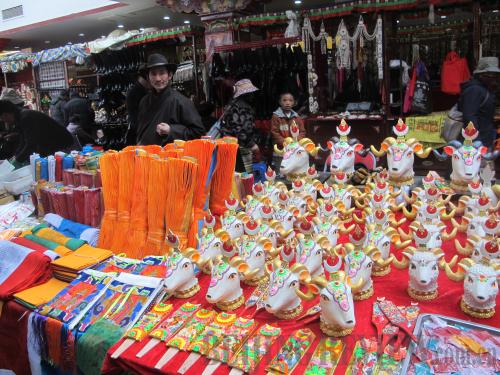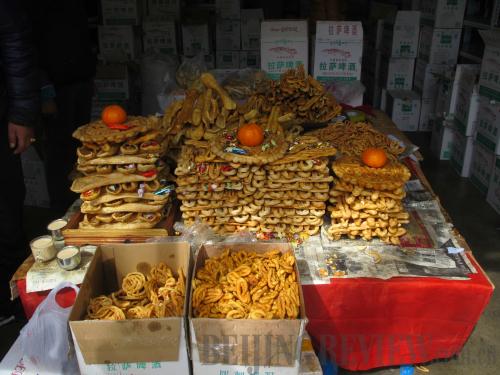|
 |
|
ORNAMENTS: Miscellaneous New Year decorations sold in Barkhor Supermarket (WANG HAIRONG) |
Weeks before the Tibetan New Year, which falls on March 2 this year, residents started to shop in preparation.
Barkhor Street in Lhasa, capital city of southwest China's Tibet Autonomous Region, was teeming with vendors and shoppers. Located in downtown Lhasa, the street is close to the Potala Palace and the Jokhang Monastery, two world cultural heritage sites.
Popular items before the New Year included clothes, barley seedlings, cloth to decorate houses, and kasai--assorted fried cereals traditionally eaten during the festival.
A number of stalls were selling kasai. Some made it on site by shaping dough into various shapes, and then frying them in butter oil and coating with sugar. Some are colored with edible pigments.
At a clothing store on Barkhor Street, Lhasa resident Gesang picked up the traditional Tibetan clothes she ordered for her family. She said that she buys new clothes for them every year. This year, she said she spent about 3,000 yuan ($489) on the three new outfits.
The cloth is woven by a textile company in the region's Shannan Prefecture, and the clothes are designed by professional designers, according to a shop clerk. "New styles are introduced from time to time. This year a short jacket on top of the long dress is in vogue," she said.
 |
|
KASAI: Kasai is the collective name of popular fried cereals eaten during Tibetan New Year celebrations. To make kasai, dough is first shaped into various forms, and then fried in butter oil and coated with sugar (WANG HAIRONG) |
Awang Ciugene, 60, sells special boxes to hold kasai at Barkhor Supermarket. The boxes are made of bamboo and leather, each costing about 300 yuan ($49). He said that in the month leading to the Tibetan New Year, he had sold more than 40 boxes, more than he would normally sell at other times of the year.
Even at a shoe stall in Barkhor Supermarket, owner Tenzing, 46, said that sales increased before the New Year.
Tenzing has been selling shoes since 1994 in various locations of the city. He said that he mostly sold cloth shoes before, now he mainly sells sport shoes and leather shoes. He said that as people's income rises, young people like to wear fashionable shoes.
"After the implementation of reform and opening-up policies, more and more varieties of commodities are available in Tibet," said Benbatsni, 47, head of Jibenggang Community of Lhasa's Chengguan District.
(Reporting from Lhasa, Tibet) | 